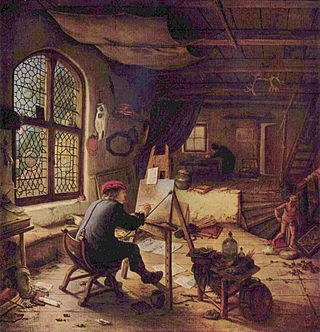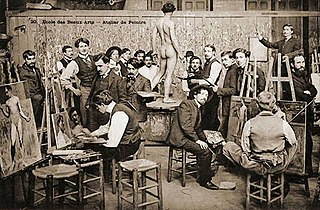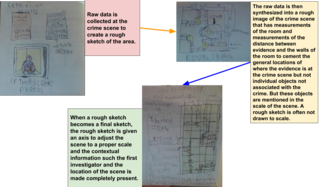Related Research Articles

"Do it yourself" ("DIY") is the method of building, modifying, or repairing things by oneself without the direct aid of professionals or certified experts. Academic research has described DIY as behaviors where "individuals use raw and semi-raw materials and parts to produce, transform, or reconstruct material possessions, including those drawn from the natural environment ". DIY behavior can be triggered by various motivations previously categorized as marketplace motivations, and identity enhancement.

A handicraft, sometimes more precisely expressed as artisanal handicraft or handmade, is any of a wide variety of types of work where useful and decorative objects are made completely by one’s hand or by using only simple, non-automated related tools like scissors, carving implements, or hooks. It is a traditional main sector of craft making and applies to a wide range of creative and design activities that are related to making things with one's hands and skill, including work with textiles, moldable and rigid materials, paper, plant fibers,clay etc. One of the oldest handicraft is Dhokra; this is a sort of metal casting that has been used in India for over 4,000 years and is still used. In Iranian Baluchistan, women still make red ware hand-made pottery with dotted ornaments, much similar to the 5000-year-old pottery tradition of Kalpurgan, an archaeological site near the village. Usually, the term is applied to traditional techniques of creating items that are both practical and aesthetic. Handicraft industries are those that produce things with hands to meet the needs of the people in their locality without using machines.

Commercial art is the art of creative services, referring to art created for commercial purposes, primarily advertising. Commercial art uses a variety of platforms for viewers with the intent of promoting sale and interest of products, services, and ideas. It relies on the iconic image to enhance recall and favorable recognition for a product or service. An example of a product could be a magazine ad promoting a new soda through complementary colors, a catchy message, and appealing illustrative features. Another example could be promoting the prevention of global warming by encouraging people to walk or ride a bike instead of driving in an eye catching poster. It communicates something specific to an audience.

Valencia College is a public college in Orlando, Florida. It is part of the Florida College System. The college was founded in 1967 as Valencia Junior College and changed its name in 2010 because the academic scope of the school had expanded to include bachelor's degrees. Valencia has several campus locations in Orlando with additional campus locations in Winter Park and Kissimmee.

A studio is an artist or worker's workroom. This can be for the purpose of acting, architecture, painting, pottery (ceramics), sculpture, origami, woodworking, scrapbooking, photography, graphic design, filmmaking, animation, industrial design, radio or television production broadcasting or the making of music. The term is also used for the workroom of dancers, often specified to dance studio.

A demo is a song or group of songs typically recorded for limited circulation or for reference use, rather than for general public release. A demo is a way for a musician to approximate their ideas in a fixed format, such as cassette tape, compact disc, or digital audio files, and to thereby pass along those ideas to record labels, producers, or other artists.

Visual arts education is the area of learning that is based upon the kind of art that one can see, visual arts—drawing, painting, sculpture, printmaking, and design in jewelry, pottery, weaving, fabrics, etc. and design applied to more practical fields such as commercial graphics and home furnishings. Contemporary topics include photography, video, film, design, and computer art. Art education may focus on students creating art, on learning to criticize or appreciate art, or some combination of the two.

Boys' Latin School of Maryland is an all-boys, university-preparatory school located in Baltimore, Maryland. Founded in 1844, it is the oldest independent, nonsectarian secondary school in the state of Maryland. The school is divided into Lower, Middle and Upper Schools. There are approximately 640 students in kindergarten through twelfth grades.
Graphic design careers include creative director, art director, art production manager, brand identity developer, illustrator and layout artist.
Community art, also known as social art, community-engaged art, community-based art, and, rarely, dialogical art, is the practice of art based in and generated in a community setting. It is closely related to social practice and social turn. Works in this form can be of any media and are characterized by interaction or dialogue with the community. Professional artists may collaborate with communities which may not normally engage in the arts. The term was defined in the late 1960s as the practice grew in the United States, Canada, the Netherlands, the United Kingdom, Ireland, and Australia. In Scandinavia, the term "community art" more often refers to contemporary art projects.

Anthony Frederick Augustus Sandys, usually known as Frederick Sandys, was a British painter, illustrator, and draughtsman, associated with the Pre-Raphaelites. He was also associated with the Norwich School of painters.

Elizabeth Shippen Green was an American illustrator. She illustrated children's books and worked for publications such as The Ladies' Home Journal, The Saturday Evening Post and Harper's Magazine.

An atelier is the private workshop or studio of a professional artist in the fine or decorative arts or an architect, where a principal master and a number of assistants, students, and apprentices can work together producing fine art or visual art released under the master's name or supervision.

A wardrobe stylist, also fashion stylist, is a consultant who selects the clothing for published editorial features, print or television advertising campaigns, music videos, concert performances, and any public appearances made by celebrities, models or other public figures. Stylists are often part of a larger creative team assembled by the client, collaborating with the fashion designer, photographer/director, hair stylist, and makeup artist to put together a particular look or theme for the specific project. A wardrobe stylist can also be referred to as a fashion stylist, fashion editor, or celebrity stylist. According to one view, "Stylists are the people who push each celebrity to make the best dressed list," and assist with editorial photo shoots.
Arts administration is a field in the arts sector that facilitates programming within cultural organizations. Arts administrators are responsible for facilitating the day-to-day operations of the organization as well as the long term goals by and fulfilling its vision, mission and mandate. Arts management became present in the arts and culture sector in the 1960s. Organizations include professional non-profit entities. For examples theaters, museums, symphonies, jazz organizations, opera houses, ballet companies and many smaller professional and non-professional for-profit arts-related organizations. The duties of an arts administrator can include staff management, marketing, budget management, public relations, fundraising, program development evaluation, and board relations.
Chicago Artists Coalition is a non-profit artist service organization based in Chicago and dedicated to building a sustainable marketplace for entrepreneurial artists and creatives. As pioneers in advocacy and professional development, it capitalizes on the intersection of art and enterprise by activating collaborative partnerships and developing innovative resources. The Chicago Artists Coalition is committed to cultivating groundbreaking exhibitions and educational opportunities, and to building a diverse community of artistic leaders that defines the place of art and artists in our culture and economy.

Forensic art is any art used in law enforcement or legal proceedings. Forensic art is used to assist law enforcement with the visual aspects of a case, often using witness descriptions and video footage.

Creative Capital is a 501(c)3 nonprofit organization based in New York City that supports artists across the United States through funding, counsel, gatherings, and career development services. Since its founding in 1999, Creative Capital has committed over $50 million in project funding and advisory support to 631 projects representing 783 artists and has worked with thousands more artists across the country through workshops and other resources. One of the "most prestigious art grants in the country," their yearly Creative Capital Awards application is open to artists in over 40 different disciplines spanning the visual arts, performing arts, moving image, literature, technology, and socially-engaged art.
Evelina "Nina" Mount (1837–1920) was a 19th-century American female artist. Born in Stony Brook, New York in 1837, as a daughter of an artist, Evelina was introduced to art at an early age by her father, Henry Mount, and her paternal uncles, Shepard Alonzo Mount and William Sidney Mount, with the latter being her mentor for the first three decades of her life. She is best known for her floral still-lifes and landscapes.
Intuit: The Center for Intuitive and Outsider Art, also known as the Intuit Art Center or just Intuit, is a museum in the West Town neighborhood of Chicago dedicated to outsider art. Founded in 1991, the museum offers exhibitions and educational programming exploring contemporary self-taught art.
References
- ↑ "I'm now editor of Professional Artist magazine". Gigi Rosenberg. 27 July 2014. Retrieved 22 December 2015.